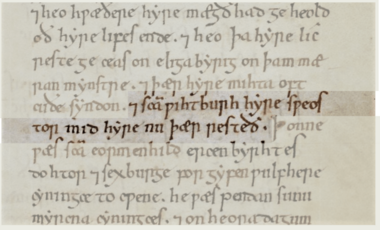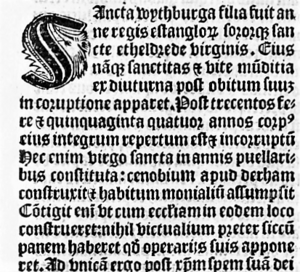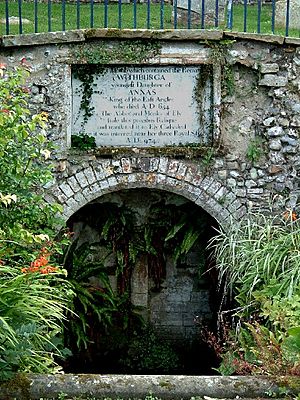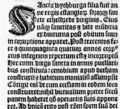Wihtburh facts for kids
Quick facts for kids Saint Wihtburh |
|
|---|---|

St. Wihtburh, depicted in St Nicholas's Church, Dereham, Norfolk
|
|
| Died | 17 March 743 Dereham |
| Venerated in | |
| Major shrine | Ely Cathedral |
| Feast | 8 July |
| Attributes | A pair of does; church |
|
Catholic cult suppressed
|
1540s |
Wihtburh (also known as Withburga or Withburge) was an East Anglian saint, a princess, and an abbess (a leader of a group of nuns). She died in 743. People traditionally believed she was the youngest daughter of Anna of East Anglia, who was the king of the East Angles. However, some historians, like Virginia Blanton, think this royal connection might have been made up later to make her story more important.
One famous story about Wihtburh says that the Virgin Mary sent two female deer to help her. These deer provided milk for the workers who were building Wihtburh's convent (a religious community for nuns) in Dereham, Norfolk. The story tells of a local official who tried to hunt these deer. He was then thrown from his horse and died.
Wihtburh was buried in Dereham when she died. It was said that her body did not decay even 50 years after her death. This was seen as a miracle, and her church and tomb became a popular place for pilgrimage (a journey to a holy place). Later, her relics (her remains) were taken by force to Ely Abbey. They were buried there next to her sisters, Æthelthryth and Seaxburh. In 1106, Wihtburh's body was checked again and was still said to be perfectly preserved.
Wihtburh's religious following, or "cult," in Eastern England was never very large. It was closely connected to her sister Æthelthryth's. During the English Reformation in the 1540s, her cult was stopped, and her relics were destroyed.
Contents
Wihtburh's Family History
Wihtburh was believed to be one of the daughters of Anna of East Anglia. Anna was a member of the Wuffingas royal family. He was a nephew of Rædwald, who was king of the East Angles from 600 to 625. The Kingdom of East Anglia was an early and long-lasting Anglo-Saxon kingdom. It covered the areas we now know as Norfolk and Suffolk in England.
Historians learn about Wihtburh's family and King Anna from old writings. These include the Historia ecclesiastica gentis Anglorum (Ecclesiastical History of the English People). This book was finished in 731 by an English monk named Bede. Another important source is the Anglo-Saxon Chronicle, which dates from the 9th century. The Liber Eliensis, written in Ely in the 12th century, also gives information about Anna and his daughters.
Bede, who wrote a lot about her older sisters, did not mention Wihtburh. This suggests he knew a lot about the family. Wihtburh's name first appears in records from the 10th and 11th centuries. Because of this, some experts, like Virginia Blanton, think that the idea of Wihtburh being related to King Anna was probably made up. This would have helped make Ely Abbey seem more important.
| Family of Wihtburh | ||||||||||||||||||||||||||||||||||||||||||||||||||||||||||||||||||||||||||||||||||||||||||||||||||||||||||||||||||||||||||||||||||||||||||||||||||||||||||||||||||||||||||||||||||||||||||||||||||||||||||||||||||||||||||||||||||||||||||||||||||||||||||||||||||||||||||||||||||||||||||||||||||||||||||||||||||||||||||||||||||||||||||||||||||||||||||||||||||||||||||||||||||||||||||||||||||||||||||||||||||||||||||||||||||||||||||||||||||||||||||||||||||||||||||||||||||||||||||||||||||||||||||||||||||||||||||||||||||||||||||||||
|---|---|---|---|---|---|---|---|---|---|---|---|---|---|---|---|---|---|---|---|---|---|---|---|---|---|---|---|---|---|---|---|---|---|---|---|---|---|---|---|---|---|---|---|---|---|---|---|---|---|---|---|---|---|---|---|---|---|---|---|---|---|---|---|---|---|---|---|---|---|---|---|---|---|---|---|---|---|---|---|---|---|---|---|---|---|---|---|---|---|---|---|---|---|---|---|---|---|---|---|---|---|---|---|---|---|---|---|---|---|---|---|---|---|---|---|---|---|---|---|---|---|---|---|---|---|---|---|---|---|---|---|---|---|---|---|---|---|---|---|---|---|---|---|---|---|---|---|---|---|---|---|---|---|---|---|---|---|---|---|---|---|---|---|---|---|---|---|---|---|---|---|---|---|---|---|---|---|---|---|---|---|---|---|---|---|---|---|---|---|---|---|---|---|---|---|---|---|---|---|---|---|---|---|---|---|---|---|---|---|---|---|---|---|---|---|---|---|---|---|---|---|---|---|---|---|---|---|---|---|---|---|---|---|---|---|---|---|---|---|---|---|---|---|---|---|---|---|---|---|---|---|---|---|---|---|---|---|---|---|---|---|---|---|---|---|---|---|---|---|---|---|---|---|---|---|---|---|---|---|---|---|---|---|---|---|---|---|---|---|---|---|---|---|---|---|---|---|---|---|---|---|---|---|---|---|---|---|---|---|---|---|---|---|---|---|---|---|---|---|---|---|---|---|---|---|---|---|---|---|---|---|---|---|---|---|---|---|---|---|---|---|---|---|---|---|---|---|---|---|---|---|---|---|---|---|---|---|---|---|---|---|---|---|---|---|---|---|---|---|---|---|---|---|---|---|---|---|---|---|---|---|---|---|---|---|---|---|---|---|---|---|---|---|---|---|---|---|---|---|---|---|---|---|---|---|---|---|---|---|---|---|---|---|---|---|---|---|---|---|---|---|---|---|---|---|---|---|---|---|---|---|---|---|---|---|---|---|---|---|---|---|---|---|---|---|---|---|---|---|---|---|---|---|---|---|---|---|---|---|---|---|---|---|---|---|---|---|---|---|---|---|---|---|---|---|---|---|---|---|---|---|---|---|---|---|---|---|---|---|---|---|---|---|---|---|---|---|---|---|---|---|---|---|---|---|---|---|---|---|---|---|---|---|---|---|---|---|---|---|---|---|---|---|---|---|---|
|
||||||||||||||||||||||||||||||||||||||||||||||||||||||||||||||||||||||||||||||||||||||||||||||||||||||||||||||||||||||||||||||||||||||||||||||||||||||||||||||||||||||||||||||||||||||||||||||||||||||||||||||||||||||||||||||||||||||||||||||||||||||||||||||||||||||||||||||||||||||||||||||||||||||||||||||||||||||||||||||||||||||||||||||||||||||||||||||||||||||||||||||||||||||||||||||||||||||||||||||||||||||||||||||||||||||||||||||||||||||||||||||||||||||||||||||||||||||||||||||||||||||||||||||||||||||||||||||||||||||||||||||
The Legend of the Does
After her father died around c. 653, Wihtburh built a convent in Dereham, Norfolk. An old religious story about her sister Æthelthryth says that Wihtburh "chose to live alone near Dereham."
A popular story tells that while she was building the convent, she only had dry bread for her workers. She prayed to the Virgin Mary for help. She was told to send her maids to a local well every morning. There, they found two wild does (female deer) that were calm enough to be milked. This milk provided a healthy drink for the workers.
The story continues that a local official did not like this miracle. He decided to hunt the does with his dogs to stop them from being milked. As punishment for his cruel act, he was thrown from his horse and broke his neck.
This legend is remembered on the town sign in the center of Dereham. The first sign was made in 1954. A new one, made of fibreglass, replaced it in 2004.
Wihtburh's Death and Burial
Wihtburh died at a very old age in 743 and was buried in Dereham. Historian Barbara Yorke has noted that this death date seems "rather late" for a daughter of King Anna.
Wihtburh is mentioned in the Anglo-Saxon Chronicle in a record for the year 799. This part was added after the Norman Conquest in 1066. It says:
A.D. 799. ... In this year the body of Witburga was found entire, and free from decay, at Dercham, after a lapse of five and fifty years from the period of her decease.
The fact that Wihtburh's body did not decay was seen as a miracle. Her remains were then reburied in the church she had built in Dereham. This church and her tomb became a popular place for pilgrimage. The large church in Dereham still has a special chapel dedicated to Wihtburh.
Moving Wihtburh's Remains to Ely

In 974, Brithnoth, the abbot (leader) of Ely, went to Dereham with monks and armed men. They planned to take Wihtburh's body by force. They held a big feast for the townspeople to distract them. After the people of Dereham found out about the theft, they chased the tomb-robbers. The robbers were attacked at Brandon by the townspeople. But Brithnoth and his men knew the local marshy areas (the Fens) well. They used this knowledge to escape their pursuers and reached Ely. Wihtburh's remains were then reburied there. When the Dereham men returned home, they found that a spring of water had appeared in Wihtburh's empty tomb.
In Anglo-Saxon England, people believed in the power of saints' cults. The remains of saints often brought gifts and money to monasteries. Smaller monasteries might not have been able to refuse requests from larger places like Ely to get their relics. This explains why Wihtburh's remains were stolen in 974. The story of the theft was written in the Liber Eliensis. The abbey tried to present the theft as a "holy sacrilege." This meant it was a respectful act, as she was being laid to rest near her older sister, Æthelthryth.
At the place where Wihtburh's tomb was, outside the west end of Dereham's main parish church, there is still a holy well linked to her. The legend says this spring appeared after her body was stolen. Another spring, called Wihtburh's Well, was recorded in the 18th century further west, but it no longer exists.
Wihtburh's burial at Ely is first mentioned in the Hyde Register. This is an 11th-century list of where English saints were buried. A sentence from this register, which is now in the British Library, says: And Sancta Wihtburh hyre sweostor mid hyre nu þǽr resteð. This means: "And Saint Wihtburh, her sister, now rests there with her." The register says she was placed near Æthelthryth, Sexburga, and Ermenilda, who was Sexburga's daughter.
In 1106, Wihtburh's body and her sisters' bodies were moved closer to the main altar in Ely. They were shown publicly to bishops, abbots, and other church leaders, including Anselm, Archbishop of Canterbury.
The description of Wihtburh's life and her body not decaying is very similar to that of Æthelthryth. Æthelthryth was also a virgin who started a monastery in East Anglia. Historian Virginia Blanton says that the important tombs of Wihtburh and her family at Ely showed how important family connections were. This, along with their stories in books like the Liber Eliensis, showed the strength of this holy family. It was seen as the foundation of the monastery's history. Other documents from the abbey show that the religious followings of Wihtburh and her sisters were part of Ely's "ideology of kinship" (the idea that family ties were very important). Ely wanted to be known as a holy place with strong connections to the East Anglian royal family. They achieved this by placing the royal tombs of Wihtburh and her sisters close together. They also wrote that King Anna's daughters were abbesses at Ely.
All the relics of the sisters were destroyed during the Reformation. No trace of the royal tombs, including Wihtburh's, exists today.
How the Legend Spread

It's not fully known how the story of Wihtburh spread. Between 1325 and 1340, an English writer named John of Tynemouth included the life stories (vitae) of the Ely saints, including Wihtburh, in his book Sanctilogium Angliae. This work was expanded in the 15th century. A new edition was printed in English in 1516 by Wynkyn de Worde and translated by Richard Pynson in the same year.
Wihtburh is also included as "St Withburge" in a book called The Lives of Women Saints of our Contrie of England. This book was written in the early 1610s.
The story of Wihtburh seems to have been important mostly in her local area. There are four images of Wihtburh (and Æthelthryth) on church screens in Norfolk. According to Blanton, showing the sisters together in these churches was likely because of Ely's historical writings. The fact that most images are found in one area suggests that Wihtburh's religious following was never very large. It was closely connected to her more famous sister, Æthelthryth.
Images for kids
-
St. Wihtburh, depicted in St Nicholas's Church, Dereham, Norfolk
-
Dereham's town sign, showing the legend of Wihtburh
-
A detail from folio 36.r of MS Stowe 944 (the Hyde Register), which names the saint as being interred at Ely Cathedral near to her sisters: And Sancta Wihtburh hyre sweostor mid hyre nu þǽr resteð. (British Library)
-
The site of Withburga's tomb in East Dereham, Norfolk
-
Extract from the legend of Wihtburh by John of Tynemouth from his Sanctilogium Angliae (1516)








